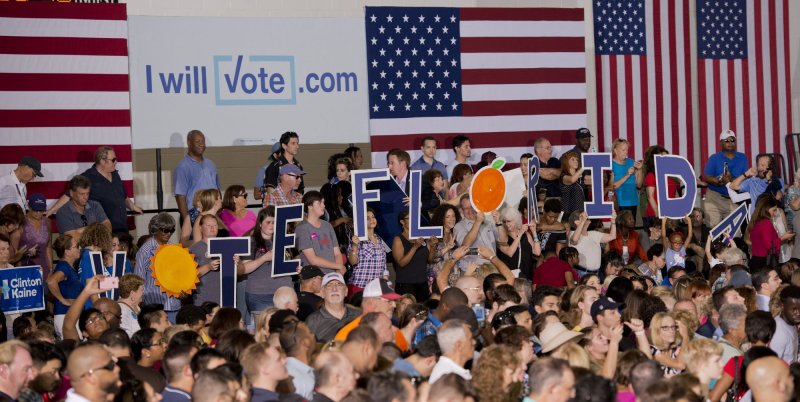The mismatch between Hillary Clinton and Donald Trump's ground game makes it difficult to read swing-states like Florida.Photo by Gary I Rothstein/UPI |
License Photo
On the organizational front, the Hillary Clinton campaign is the iPhone 7 and the Donald Trump effort is a telephone made from two tin cans and a ball of string. Even Republicans concede that Clinton boasts an overwhelming advantage in field offices, voter targeting and data analytics.
This mismatch in the ground game makes it difficult to read swing-state polling. Should you add 1 percent to Clinton's numbers because of a more sophisticated get-out-the-vote operation? Or 3 percent? Or nothing?
The 2012 Obama campaign deployed as many as 2 million volunteers to talk to voters on their doorsteps and in personalized phone conversations. All the evidence suggests that such volunteer-based voter contact is the most potent form of persuasion and mobilization.
What we won't know until Election Day (since campaign claims are suspect) is how big a volunteer army the Clinton campaign has been able to enlist. The best voter targeting operation in world history loses its luster if the Democrats have to rely on paid canvassers or can't reach many of the voters they need to turn out.
While funding of campaign commercials can be murky in a "Citizens United" world, there is no such thing as a stealth TV ad. Since both broadcast television and cable networks are regulated, even TV spots aired on obscure cable channels at 4 a.m. are monitored by the media and rival campaigns.
But Facebook, Twitter, Instagram and other forms of social media are private businesses. What that means is that what campaigns do on Snapchat stays on Snapchat unless the company chooses to disclose it — or a reporter or political partisan stumbles on it. If television is the town square, then social media is a privately owned shopping mall with burly security guards.
One of the enduring mysteries of this campaign is how the Clinton and Trump forces are targeting and persuading voters through social media.
What clues I've picked up suggest that the Clinton campaign is more bureaucratic than innovative in its use of social media. It may not be as bad as 2012 when 22 Mitt Romney staffers had to approve every tweet and Facebook post, but the Hillary efforts are almost as ossified.
In contrast, the Trump campaign (which often appears to believe that buying red baseball caps is a cutting edge campaign tactic) may be doing more than expected on social media. Such activity would not be apparent from campaign spending disclosures, since the buys are being handled by third-party vendors.
Whether any of this will matter on Nov. 8 is impossible to tell. If not in 2016, then certainly by 2020, campaigns will have mastered the subterranean tricks of exploiting social media.
About 10 percent of likely voters claim that they intend to cast protest votes for Gary Johnson (7.4 percent in the latest RealClearPolitics polling average) and Jill Stein (2.5 percent). Leaving aside the dubious merits of both candidates, this mass voter rebellion against the major-party nominees is unprecedented in modern political history.
Both segregationist George Wallace in 1968 (13.5 percent of the vote) and maverick businessman Ross Perot in 1992 (18.9 percent) and 1996 (8.4 percent) attracted dedicated loyalists. In fact, a post-election poll in 1992 found that 77 percent of Perot voters said they had cast a ballot for their favorite candidate rather than protesting the Democratic and Republican nominees.
There is little evidence from polling that Johnson and Stein arouse that kind of enthusiasm, except among their most ardent supporters. So will the support for Johnson and Stein dwindle as Nov. 8 nears?
The historical evidence is mixed. In both 1992 and 1996, Perot consistently maintained his support from early October through Election Day. But in 1980 (long before today's millennial voters were born), independent John Anderson, a liberal Republican congressman, drooped badly throughout the fall. As late as mid-October, Anderson was garnering 12 percent in the polls only to limp home with just 6.6 percent of the vote.
One last factor to bear in mind — Bill Weld, Johnson's running mate, keeps inching closer to a Clinton endorsement. Weld, a former moderate Republican governor of Massachusetts, recently told The Boston Globe that his single-minded focus in this campaign is defeating Trump. Weld also said recently that nobody "is more qualified than Hillary Clinton to be president."
In a weird year, it wouldn't take much for the mercurial Libertarian veep to end the race campaigning side by side with the Democratic nominee.
Get breaking news alerts and more from Roll Call on your iPhone or your Android.















